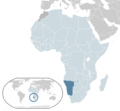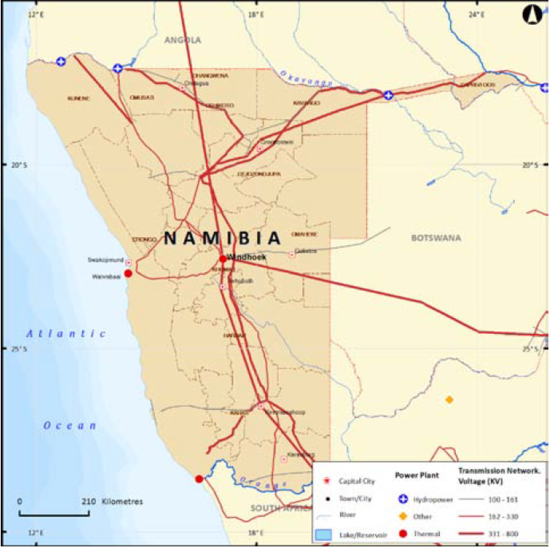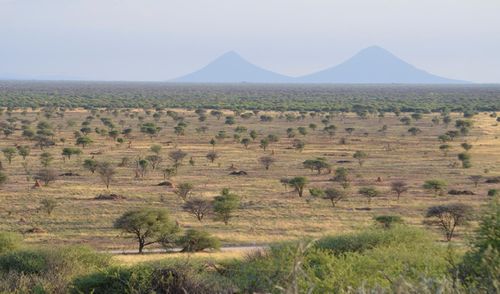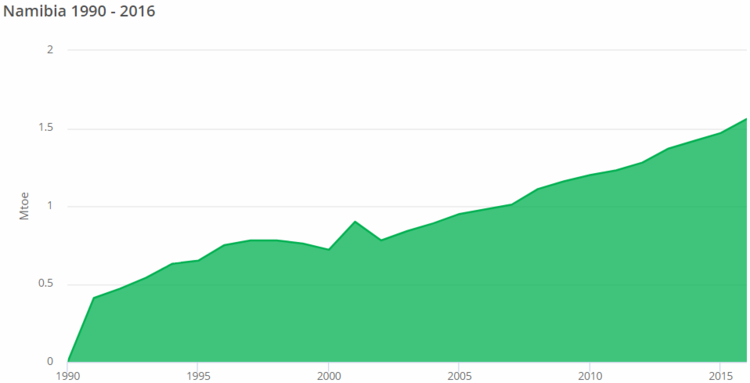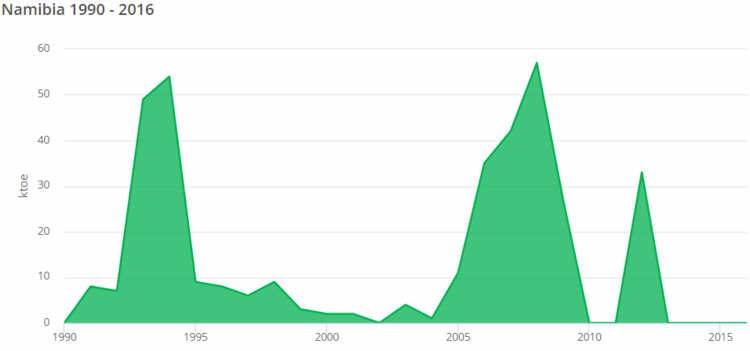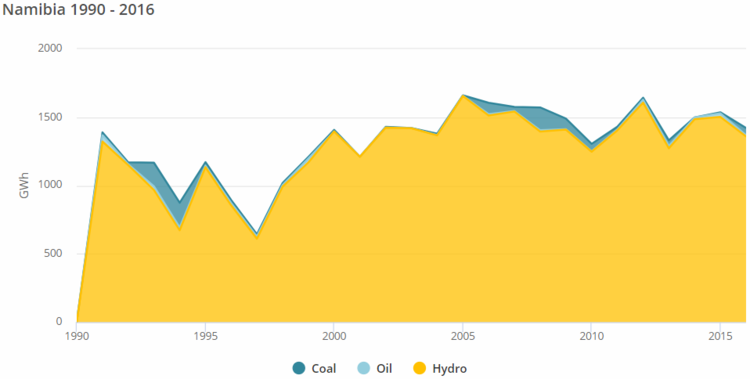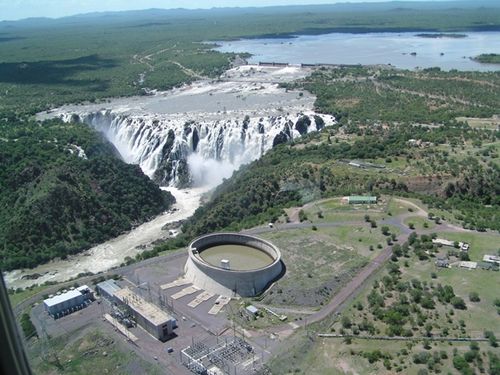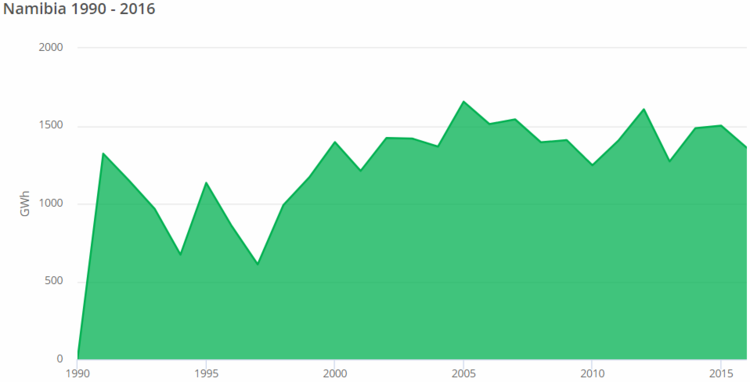Namibia Energy Situation
Capital:
Windhoek
Region:
Coordinates:
22.5700° S, 17.0861° E
Total Area (km²): It includes a country's total area, including areas under inland bodies of water and some coastal waterways.
824,290
Population: It is based on the de facto definition of population, which counts all residents regardless of legal status or citizenship--except for refugees not permanently settled in the country of asylum, who are generally considered part of the population of their country of origin.
2,567,012 (2022)
Rural Population (% of total population): It refers to people living in rural areas as defined by national statistical offices. It is calculated as the difference between total population and urban population.
46 (2022)
GDP (current US$): It is the sum of gross value added by all resident producers in the economy plus any product taxes and minus any subsidies not included in the value of the products. It is calculated without making deductions for depreciation of fabricated assets or for depletion and degradation of natural resources.
12,914,932,656 (2022)
GDP Per Capita (current US$): It is gross domestic product divided by midyear population
5,031.12 (2022)
Access to Electricity (% of population): It is the percentage of population with access to electricity.
55.23 (2021)
Energy Imports Net (% of energy use): It is estimated as energy use less production, both measured in oil equivalents. A negative value indicates that the country is a net exporter. Energy use refers to use of primary energy before transformation to other end-use fuels, which is equal to indigenous production plus imports and stock changes, minus exports and fuels supplied to ships and aircraft engaged in international transport.
74.44 (2014)
Fossil Fuel Energy Consumption (% of total): It comprises coal, oil, petroleum, and natural gas products.
66.72 (2014)
Introduction
Namibia lies in the southern part of the African continent. It borders the Atlantic Ocean to the west, Angola to the north, Zambia to the north-east, Botswana to the east, and South-Africa to both south-east & south.
Energy Situation
Overview of the Country's Energy Sources
Namibia's top energy sources are petroleum, hydropower, imported electricity, and imported coal[1]. The country's own internal resources supply less than one-third of its needed energy requirements[2].
Namibia has high potential for solar, wind and biomass generation[1]. Invade bush is widely spread in the country's northern parts, which allows a large scale bioenergy-based production capacity[3][1].
The country is also on the top 10 listed countries, which are in possession of uranium resources worldwide, and it solely supplies about 8.2% of the global uranium production[3].
Energy Access
There are around 1 million Namibians lack access to electricity, which means that almost half of the country is without access at all (~53% has access & ~47% has no access)[4][5].
According to the REN21-SADC Renewable Energy and Energy Efficiency Status Report (2018), the challenge in Namibia is to provide electricity access to the 79% of the rural and sparse population that does not have access by establishing feasible and maintainable off-grid solutions. The Rural Electricity Distribution Masterplan 2010 prioritises 2,879 rural localities to be electrified in the next 20 years and identifies 27 localities for off-grid electrification (including via renewables); however, implementation has been limited.[6]
So far the country has developed several pilot mini-grids, including three off-grid systems: Gobabeb, Tsumkwe Mini Grid and Gam Solar PV Mini Grid. In rural and remote areas where neither the main grid nor mini- grids are available, consumers depend on stand-alone electricity sources, mainly diesel generators. The use of solar technologies has been increasing, and hybrid solar/diesel systems have proved to be technically sound off-grid solutions.[7]
Production
| Source | Unit | 2000 | 2005 | 2013 | 2014 | 2015 | 2016 | 2017 | 2018 |
|---|---|---|---|---|---|---|---|---|---|
| Charcoal | Kt | 72 | 102 | 135 | 145 | 161 | 161 | 161 | 163 |
| Hydroelectricity | GWh | 1380 | 1658 | 1227 | 1485 | 1502 | 1396 | 1416 | 1436 |
| Electricity | GWh | 1414 | 1709 | 1300 | 1517 | 1555 | 1505 | 1530 | 1557 |
Installed Capacity
Consumption
Namibia's average consumption rate surpasses 3000 GWh/year, while its generation capacity is around 1305 GWh/year[1]. Therefore, there is a supply gap, which is covered by importing power from South-Africa, Zambia, and Mozambique[1].
| Source | Unit | 2000 | 2005 | 2013 | 2014 | 2015 | 2016 | 2017 | 2018 |
|---|---|---|---|---|---|---|---|---|---|
| Coal | Kt | 0 | 0 | 26 | 161 | 179 | 181 | 184 | 186 |
| Oil | Kt | 400 | 460 | 815 | 913 | 1195 | 1770 | 1868 | 1994 |
| Natural Gas | TJ | 0 | 722 | 2925 | 3866 | 6390 | 6099 | 6233 | 6383 |
| Electricity | GWh | 2078 | 9079 | 10536 | 11724 | 11358 | 11384 | 12244 | 13203 |
Most of the final consumed energy goes to the country's transport sector[1].
Import and Export
| Year | 2000 | 2005 | 2013 | 2014 | 2015 | 2016 | 2017 | 2018 |
|---|---|---|---|---|---|---|---|---|
| Imported Oil Capacity (Kt) | 534 | 501 | 1337 | 1024 | 1171 | 1941 | 2098 | 2283 |
Electricity
Namibia's generated electricity comes mainly from:
- the 240 MW hydroelectric power plant on the Kunene river in Ruacana,
- the 120 MW van Eck coal-powered plant north of Windhoek,
- the Paratus 24 MW heavy fuel-oil powered plant in Walvis Bay,
- the 5.78 MW solar plant in Trekkopje in the Erongo region. [2].
The Ruacana hydrowpower plant is a run‐of‐river station. The amount of power generated depends on the water flows from Angola. In case of insufficient flows, power generation is low.
The installed electrical generation capacity is insufficient to meet the demand for electricity. Therefore, Namibia is importing large amounts of electricity from neighboring countries mainly South-Africa. The crossborder transmission lines have a capacity of 600 MW. Another transmission line is presently built, extending the transmission system to Zambia and Zimbabwe and will have another additional capacity of 600 MW.
| Production | Consumption | Exports | Imports | Installed Generation | |
|---|---|---|---|---|---|
| Capacity | 1.403 billion kWh | 3.891 billion kWh | 88 million kWh | 3.073 billion kWh | 535,500 kW |
| World Ranking | 145 | 128 | 83 | 50 | 146 |
28% of Namibia's generated electricity come from fossil fuels, while 64% are from hydropower, and about 8% come from renewables[4].
Energy Security
Renewable Energy
Non-electricity off-grid renewable energy projects include the small/ micro wind energy installations used for water pumping, which are very common in Namibia, especially on farms. This technology has been used successfully for decades, with about 30,000 wind- driven water pumps installed in the country as of 2005; however, the current trend is to replace these with solar energy sources.[9]
General Indicators
| Year | 2009 | 2010 | 2011 | 2012 | 2013 | 2014 | 2015 | 2016 | 2017 | 2018 |
|---|---|---|---|---|---|---|---|---|---|---|
| Capacity | 244 | 245 | 248 | 342 | 345 | 347 | 357 | 384 | 394 | 431 |
Solar
The solar conditions in the Namibian region are to be considered of the best worldwide for solar generation[1][2]. The country's average high direct solar insolation is 2200 kWh/m2/year, with a cover of minimum clouds[1][2]. The southern region of Namibia experiences -on average- 11 hours of sunshine/day, and an average direct solar radiation of 3000 kWh/m2/year[1]. With these conditions, Namibia has a huge potential for installing solar water heaters, solar photovoltaic (PV) systems, and concentrated solar power (CSP) plants[1].
Namibia's most common PV technology application is solar PV-based pumping, which is mainly used in cattle farms[1]. Secondary solar applications in the country would be rural electrification, powering radios, lighting, TVs, and fans[3].
| Year | 2009 | 2010 | 2011 | 2012 | 2013 | 2014 | 2015 | 2016 | 2017 | 2018 |
|---|---|---|---|---|---|---|---|---|---|---|
| Capacity | 4 | 4 | 7 | 11 | 15 | 16 | 27 | 36 | 46 | 79 |
The Solar Revolving Fund under the Ministry of Mines and Energy continues to subsidise stand-alone solar systems for individual household use: between 2015 and 2017, it financed some 1,600 solar systems (water heaters, pumps and solar home systems).
Hydropower
Hydropower is the country's major source for electricity generation, particularly, the Ruacana hydroelectric power station (330 MW)[3].
| Year | 2009 | 2010 | 2011 | 2012 | 2013 | 2014 | 2015 | 2016 | 2017 | 2018 |
|---|---|---|---|---|---|---|---|---|---|---|
| Capacity | 240 | 240 | 240 | 330 | 330 | 330 | 330 | 347 | 347 | 347 |
Bioenergy
EEP Africa supported a very successful biomass energy project that is harvesting invader bush – which covers substantial areas of northern Namibia – for use in a steam boiler. The project, Combating Bush Encroachment for Namibia’s Development, has installed a 250 kW bush-to electricity gasification pilot power plant on a commercial farm in the heavily bush-infested Otavi area. The plant, which was not yet operational as of mid-2018, is considered as a proof-of-concept project to determine the financial feasibility of this approach, assess the robustness of the technology and establish Namibia’s first IPP.
Fossil Fuels
Oil
Liquid fuels in general, and oil in particular are widely used in Namibia's both household and industrial sectors[11]. Diesel and petroleum are the most used liquid fuels in the country, especially in the transport sector (~63% of Namibia's total consumed energy)[11].
Coal
Namibia uses coal solely for generating electricity, thus through the country's only coal-powered station (Van Eck Power Station)[11]. All the coal used in Namibia is imported, and it mostly comes from South-Africa[11].
Key Problems of the Energy Sector
For Namibia to develop its energy sector and achieve energy security for the decades to come, some challenges need to be mitigated and handled properly at the first place, from which some are listed below[12][2]:
- The needed technology and engineering skills in the country are limited and underdeveloped.
- The foreign investment in the country's energy sector is very limited.
- The country lacks both incentives and national targets for developing and improving its energy sector.
- No national investments have been carried out during the past 3-4 decades, neither for developing the energy sector, nor for improving and increasing the country's electricity generation capacity.
- The local electricity tariffs, when compared to other nations in the region, are considered to be on the low level.
- The high cost of energy supply.
- The continuous droughts, which decrease the water dispatch in the Ruacana Station (Namibia's main energy supplier), consequently, the energy sector is more often incapable of meeting electric demand.
Policy Framework, Laws and Regulations[13] [14]
Institutional Set up in the Energy Sector[13] [14]
National Government
- The Ministry of Mines and Energy (MME):regulates the energy and mining resources, also responsible for rural electrification.
- The Ministry of Environment and Tourism (MET):has the mandate to advance climate change activities in Namibia
- The Ministry of Finance(MoF): provides funding for, e.g., the Environmental Investment Fund (EIF), which supports NGOs, SMEs and local governments.
- The Ministry of Trade and Industry (MTI):has a depratment to enhance Foreign Direct Investments.
Regulatory Authority and Government Agencies
- The Electricity Control Board(ECB)wasestablishedin2000. Its role is to regulateelectricity generation, transmission, distribution, supply, import and export in Namibia through setting tariffs and issuing licenses.
- The National Technical Committee on Renewable Energy (NTCRE)of the Natiional Standards Institute (NSI): develops norms, standards and codes of practice for the performance, manufacture, installation and maintenance of renewable energy technologies. In 2006 it issued a Code of Practice and Register of Products and a list of approved technologies and suppliers.
- List of energy related Standards (Nov 2019)
- Namibia Investment Centre (NIC):with the major responsibility of promoting FDI (Foreign Direct Investment).
- The National Planning Commission is responsible for planning national priorities and ensuring that climate change considerations are properly reflected in sector plans and budgetary allocations.
Power Producers
|
On grid (Government) |
On-grid (IPP) |
Off-grid |
|
|
Banks
- Kongalend (micro-lender, Kongalend works in partnership with technology suppliers and technicians). They lend to individuals and SMEs for renewable energy at an interest rate of up to 15.6% only after verifcation of formal income.
- Development Bank of Namibia (provides finance to larger scale IPPs)
- Bank Windheok
- First National Bank (Individual loans are available through First National Bank (FNB), South African based, for the installation of renewable energy in homes.)
- RMB Bank
- SME Bank (suspended involvement in EIF due to irregularities of SME Bank, see EEP p.65))
- Standard Bank
- AgriBank
Private sector
There are about 50 solar technology companies.[14] „The number of local, established renewable energy companies in Namibia is low. Most companies focus on project development, engineering-procurement-construction (EPC) activities and installation of photovoltaic and solar thermal solutions. The established, local companies, some of which have been active in the field of renewable energies for more than 10 years, generally have sound know-how and technical understanding. As there is no formal training in the field of renewable energies in Namibia, employees are individually trained by the companies. Thus, the quality and the level of education of local companies and specialists can vary considerably.“[15]
- officialList Of Approved & Registered Installers And Suppliers(40 PV installers, 14 solar thermal installers, 47 RE installers with phone number and email addresses)
D-Lab’s Off-Grid Energy Groupprovides aggregat ed information about solar lighting products:Products and Distributors by Country: information sheets containing information on products available in a given country.
They list 4Namibian Distributors with email, two of them from South Africa(13 April, 2017)
- 1) Restio Energy , South Africa
- 2) Solar Works!, South Africa
- 3) SolarAge Namibia, Namibia
- 4) TOTAL Awango Namibia
online available information about private companies:
- Home Solar Solutions Supplier | Taatisolar Namibia (2 shops)
- LSN – A Renewable Energy Company focused on Solar Technology(693 Happy Clients, 1325 kWp Installed Capacity, 3284642 kWh’s Generated)
- Solar Age cc.(since 2017 new management: https://www.facebook.com/Solar-Age-CC-140386303385036/ )
- SolarLink
- Sunrise Solar Solutions CC - Home | Facebook
- NamSolar Namibia Solar Solutions
- africanenergy.com in namibia-installers/
- Solsquare Namibia
- Continental Solar Warehouse
- Ellies Renewable Energy Windhoek
- HopSol
- O&L Energy Ohlthaver & List Group is the largest private Namibian company group.
- Woermann & BrockThe leading Namibian supermarkets group with branches across the country. With solar installations on their facilities.
- Solar-Saver | Rent the Sun(since 2016 rooftop solar photovoltaic systems; Stimulus Investments has invested in 2018; “Our current rental portfolio includes 46 solar PV systems, with clients ranging from retailers to fuel stations, hospitals and many other businesses. Demand for our offering has been tremendous, and our project pipeline should see us commissioning further 60 PV systems this year,” said Tim Frankish, one of the shareholders and directors of Solar-Saver. 2018)
Associations/Research institutions
Renewable Energy Industry Association of Namibia (REIAoN)
- Renewable Energy Industry Association of Namibia. Fifty members focus on solar energy and three on wind. This list is used for the basis of the EIF programme which provides credit to end users to purchase and install RE products.[13] (No activities on their webpage since 2015.)
Other associations
- Association of consultant Engineers of Namibia
- Namibia Manufacturers Association
- Namibia Chamber of Commerce and Industry
Namibia Energy Institute (NEI)
- Formally known as theRenewable Energy and Energy Efficiency Institute (REEEI),itwas established by the Government within the Polytechnic of Namibia in 2006. It is disseminating research and information about renewable energy as well as providing technical assistance to the MME inthe implementation of renewable energy projects and programmes including addressing barriers to renewable energy development.
- The National Energy Institute (NEI), operating under the Namibia University of Science and Technology, has the mandate to undertake research, development, capacity building and awareness creation in the energy field, including energy efficiency.
- They have 4 Centres: CREEE (for Renewable Energy and Energy Efficiency), CES for Electricity Supply, CPOG for Petrolleum, Oil and Gas and CNS for Nuclear Siences.
Since 2006, several projects are/were implemented:
- Scoping Study for OGMP
- Status of Energy Report
- CSP feasibility study (50-100 MW)
- large PV regulations for procurement
- regulatory framework for netmetering
- NEEP in Buildings
- SOLTRAIN solar thermal training and demonstration initiative
- National Integrated Resource Plan
- SACREEE
- EU REDCROSS Promoting Renewable Energy for Climate Change Mitigation Initiative in Namibia (implemented from March 2017 to April 2019 to communities in Kavango East and West regions; close to 300 households benefitted from the project and that two solar-powered boreholes were constructed in Mayana and Sharukwe community gardens.)
Desert Research Foundation of Namibia (DRFN)
The Desert Research Foundation of Namibia was established to support research but also to address sustainable development throughout arid lands. The DRFN tackles issues ranging from water to energy to land from a human and a basic biophysical perspective, as well as undertaking awareness and capacity building necessary to support this approach.
Other Key Actors / Activities of Donors, Implementing Agencies, Civil Society Organisations
NGOs
Elephant Energy Trust
Elephant Energy has worked with partners including the Peace Corps and World Teach to identify schools in the north eastern and central regions of Namibia that are in need of lighting resources and can act as reliable stewards of the libraries for years to come. Thus far, EE has distributed more than 800 lights allowing 6,500 learners access to light. Elephant Energy has more than 40 Sales Agents through Namibia. https://www.elephantenergy.org/v2-sales-agents
Citizen Trust
(no information about them yet)
Donor Involvement
„There is not a great deal of donor related activity being implemented in Namibia, with the exception of the regional programmes being implemented. KfW Bank, AfDB and the Green Climate Fund (GCF) are providing large-scale fi-nancing and the UNDP, World Bank and GIZ are involved in the development of energy resources for Namibia. GIZ is particularly focused on developing biomass using the invader bush that has proved to be a hindrance for Namibian farmers. The EU has supported some projects under its climate change programme and supports the installation of solar water pumps for farmers.“[13]
Implications for the Theory of Change: „Small-scale IPP projects are bankable despite the lack of government guarantees due to a general market confi-dence in the stability of Nampower and the government. However, currency fluctuations and the devaluation of the Rand appear to affect private sector willingness to take loans geared to foreign currency. The continued expansion of small-scale, renewable projects may not be promoted by ECB in the short term due to difficulties in managing the variable supply from renewable energy IPPs and the current supply infrastructure. Developing bankable off-grid projects is challenging in Namibia due to the absence of an economy of scale. There is potential in peri-urban areas, which would then satisfy the TOC however this would require a change of regulation to allow for the direct distribution to local customers. Rent-to-own business models, such as those of Mobisol and Off:Grid Electric may be more suited to this context, although there may need to be guarantees in place if the grid were to be extended to these areas.“[13]
Past and current involvement of donors
(List is still not sorted)
|
Funding by... |
Current projects |
Past involvement |
Information |
|
AFD |
0 on their homepage
|
1 Grid project „Sustainable Use of Natural Resources and Energy Finance Fund“ |
„Namibia’s second-largest lender, Bank Windhoek last November issued a green bond on the Namibia Stock Exchange to fund renewable energy projects. It’s also financing projects as implementing partner of the Sustainable Use of Natural Resources and Energy Finance Fund, which was established by the French Development Agency.“
|
|
Finnland (embassy) |
|
Solar water project |
the first of what’s expected to be a series of 100% solar-powered desalination systems developed by Finland’s Solar Water Solutions along the beach line adjacent to the University of Namibia’s Henties Bay campus. A joint development initiative on the part of the University of Namibia and Finland’s University of Turku, which funded the project for an approximate cost of around 3.2 Namibian dollars (~USD212,000). |
|
Finnish Embassy’s Local Cooperation Fund. |
|
Energy Shops |
The cost of the three-year pilot phase of implementation of the Energy Shops was estimated at N$7,603,000 (DRFN 2008), including the cost of short-term consultancy (N$1,085,000), and the annual funding for the implementing agency, the awareness campaign, the Solar Revolving Fund, and the equipment for the first 20 Level 1 Energy Shops (N$6,518,000). Evaluation of the first phase: see p. 44 in NAMA 2015 |
|
WEF, WB, IFC, ADB, IRENA |
Namibia and Botswana’s five-gigawatt solar power development partnership |
|
Namibia and Botswana’s five-gigawatt solar power development partnership with WEF’s Global Future Council on Energy will be carried out in multiple phases over the course of the next 20 years and leverage the collective expertise and resources of the organizations involved. From the Global Future Council on Energy’s side, that includes the World Bank Group, the International Finance Corp., the African Development Bank, the Africa Renewable Energy Initiative, the New Partnership for Africa’s Development, the International Renewable Energy Agency (IRENA), and Power for Africa. |
|
2016-2022
|
|
Proposal: „to provide rural crop males and females farmers with alternative sustainable access to off-grid solar energy technologies (water pumping for small-scale micro horticultural systems, and refrigeration for harvested food) and reduce the dependency of increasingly expensive (and environmentally unfriendly) imported fuels by promoting solar water pumping in the agricultural sector.“ „Some piloting activities have already been carried out with government support, such as at Tsumkwe with off-grid solar village connection. To date, there are no major renewable energy pilots in the CRAVE project targeted areas. In the three target regions, there is a huge need to improve SSF access to clean energy sources to enable them to improve their production activities, especially for agricultural water pumping services.“ Outcome 3.1 Alternative sustainable access for off-grid solar energy technologies widely promoted, adopted and applied (in the three targeted regions) (SSHF and SSF) Output 3.1 Solar Water Pumping for Agriculture | |
|
Wast to energy, on-grid project |
|
Doranova Finnish company; waste to energy- biogas 400 kW pilot project, on-grid in Ondangwe | |
|
USAID |
since March 2017 |
|
Southern Africa Energy Program (SAEP) provides technical assistance support to various public and private stakeholders, including ECB, NamPower, and the Ministry of Mines and Energy related to five outcomes: Improved Regulation, Planning, and Procurement for Energy; Improved Commercial Viability of Utilities; Improved Regional Harmonization and Cross-Border Trade; Scaled Renewable Energy and Energy Efficiency; and Increased Human and Institutional Expertise. |
|
WB: Additional Financing for SAPP AREP Program - MDTF |
|
|
Relevant for energy access? https://projects.worldbank.org/en/projects-operations/project-detail/P163545 |
|
Water desalination plants, since 2018, 4 years |
|
Namibia Pilot rural desalination plants using renewable power and membrane technology, via Namibia Water Corporation Ltd (NamWater) | |
|
UK Aid |
? |
X |
(for development of a climate financing strategy and programme) |
|
Turkey, Finland |
? |
X |
(both to address bush encroachment) |
|
Germany |
? |
X |
|
| USA |
Millennium Challenge Corporation |
MCC’s support focuses on education, tourism, health and livestock.[16] | |
| China |
"China is now Namibia’s third largest provider of bilateral development assistanceand has invested in a number of sectors, including construction and mining."[16] | ||
| EU |
The European Union(EU) is focusing on basic infrastructure (water, sanitation and roads), human resources development (education and health) and governance[16] | ||
|
Cheetah Conservation Fund |
Bushblok project |
|
Wood briquettes
|
|
Energy For Future |
Bush-to-Fuel Project |
|
Wood chips for cement plant |
|
? |
CBEND project |
|
A 250 kW bush-to-electricity power plant on a commercial farm in the Otavi area (proof of concept; Namibias first IPP) |
|
Q&L (funding by EEP) |
Thermal heat plant |
|
Hot water supply for brewery. |
|
Elephant Energy |
Rent-to-own model for SHSs |
|
|
|
Pilot cookstove project by EEP |
Dissimination of stoves by SMEs in rural areas |
|
|
Climate Financing
"The Global Environment Facility (GEF) has been the biggest and most consistent donor in Namibia’s Climate Environment Energy fraternity. As mentioned in section 2.2, Germany has been the mainstay bilateral donor for CEE since Namibia’s Independence. The following CEE projects are active:
Namibia National Parks Programme (US$4.2m); Biodiversity Management and Climate Change (US$7.5m); Resource Mobilisation for Effective Implementation of the Updated Biodiversity Strategy (US$3.13m);Bush Control and Biomass Utilisation (US$12.5m); Support to Land Reform Beneficiaries (US$2.5m); Adaptation of agriculture to climate change in northern Namibia (US$7.5m); Community-based natural resource management (US$6.25m); SDG initiative (US$3.75m); Conservation and sustainable use of the Benguela Current large marine ecosystem (US$11m); Transboundary water management in SADC (US$17.76m); Sector support to combat desertification (US$7.9m) and transboundary conservation and use of natural resources in SADC (US$10m)."[17]
The Annex 11: Namibia’s energy generation and access situation – financing and investments lists a total investement of 101,426,307 USD by 5 private entities, 2 state-owned entities (larges share by the Development Bank of Namibia) and the micro-medium lender Kongalend.[17]
Further Information
- Partnership Ready Namibia: Renewable energy, GIZ Global Business Network (GBN) Programme Jan 2020; Brief_Namibia_RenewableEnergy_E_WEB.pdf https://www.giz.de/en/downloads/GBN_Sector Brief_Namibia_RenewableEnergy_E_WEB.pdf
- Blimpo, Moussa P., and Malcolm Cosgrove-Davies. 2019. Electricity Access in Sub-Saharan Africa: Uptake, Reliability, and Complementary Factors for Economic Impact. Africa Development Forum series. Washington, DC: World Bank. doi:10.1596/978-1-4648-1361-0. License: Creative Commons Attribution CC BY 3.0 IGO https://www.afd.fr/sites/afd/files/2019-05-02-38-26/electricity-access-sub-saharan-africa.pdf
- Sourthern Africa Energy Program (SAEP)- December 2019. Power Africa. Example – Better Storage as a RE technology. Tsumkwe plant in Namibia. Documents/Standards Activities/International Standardization/CESP/USAID-SAEP.pdf https://share.ansi.org/Shared Documents/Standards Activities/International Standardization/CESP/USAID-SAEP.pdf
- PROCEEDINGS of the Conference on Solar Power Systems for NamibiaSolar Energy for Rural Development 16 –18 May 2018 http://unam.edu.na/sites/default/files/proceedings_of_spsn_2018_-_presentations.pdf
- Renewable Energy Market Landscape Study covering 15 countries in Southern and East Africa, EEPS&EA, August 2017 https://www.entwicklung.at/fileadmin/user_upload/Dokumente/Regionen/Volume_II_Market_Landscape_-Study_-EEP-SEA_CountryProfiles_StakeholderMaps-1.pdf
- REN21, 2018. SADC Renewable Energy and Energy Efficiency Status Report (Paris: REN21 Secretariat) http://www.ren21.net/wp-content/uploads/2018/12/SADC_2018_EN_web.pdf
- UNICEF Climate Landscape Analysis for Children in NamibiaFinal Report (2018) https://www.unicef.org/namibia/na.UNICEF_CLAC_Report_August_2018.pdf
- Munyayi, R. Chiguvare, Z. & Ileka, H. (2015). Fact Sheet on: Renewable Energy – Shifting Energy Systems in Namibia towards a More Sustainable Path. https://www.thinknamibia.org.na/files/learn-and-engage/jtBTlZQO-YnHdSkT.pdf
- Nationally Appropriate Mitigation Action: Rural Development In Namibia, 2015, and Energy/MDG Carbon Facility/NAMA Final Namibia 2.pdf https://www.undp.org/content/dam/undp/library/Environment and Energy/MDG Carbon Facility/NAMA Final Namibia 2.pdf
- Energy Demand and Forecasting in Namibia: Energy for Economic Development (2013)
- Renewable Energy for Rural Development: A Namibian Experience (2012)
- Namibian National Issues Report on the Key Sector of Energy with a Focus on Mitigation (2010)
- Namibia's Energy Future: A Case for Renewables (2012)
- Electricity Supply Industry: National Policy of Independent Power Producers (IPPs) in Namibia (2017)
- Namibia's Energy Support Problem: The Epupa Scheme (1997)
- Energy in Namibia - VO CONSULTING.pdf Green Energy in Namibia (2009)
- SECTOR NATIONAL INTEGRATED RESOURCE PLAN (NIRP) 2016 FINAL REPORT.pdf Namibia Electricity Supply Industry: National Integrated Resource Plan Review and Update (2016)
- Africa-EU Renewable Energy Cooperation Programme (RECP): Higher Education for Renewable Energy - Country Mapping of Namibia (2015)
- Renewable Energy Policy for the Republic of Namibia.pdf National Renewable Energy Policy for the Republic of Namibia (2016)
- An Empirical Analysis of Energy Demand in Namibia (2005)
- Renewable Energy Transition for a Sustainable Future in Namibia - Master's Thesis (2012)
- Development of Namibian Energy Sector (2013)
- Energy Policy - July 2017.pdf Namibia's National Energy Policy (2017)
- Fact Sheet on Renewable Energy: Shifting Energy Systems in Namibia towards a more Sustainable Path (2015)
- Renewable Energy Market in Namibia (2012)
- Renewable Energy and Energy Efficiency Partnership (REEEP): Namibia Profile (2014)
- Namibia: Rapid Assessment and Gap Analysis
- Namibia: Nine Renewable Energy Projects Connected to Grid (2018)
- Gender and Biomass Energy Conversion in Namibia: A Case Study with Special Reference to GTZ/ProBEC Interventions (2001)
- Solar Thermal Technology Roadmap for Namibia: A Vision of Namibia's Solar Thermal Energy Future
- Supportive Framework Conditions for Mini-Grids Employing Renewable and Hybrid Generation in the SADC Region: Namibia Case Study, Gap Analysis and National Action Plan (2014)
- Harvesting of Encroacher Bush: Compendium of Harvesting Technologies for Encroacher Bush in Namibia (2015)
- Groundwater in Namibia: An Example to the Hydrological Map (2011)
- Policies and Institutions for Assuring Pro-Poor Rural Development and Food Security through Bioenergy Production: Case Studies on Bush-to-Energy and Jatropha in Namibia (2016)
- Bush-to-Electricity in Namibi (2017)
- Solid Biomass Energy in Namibia (2017)
- Namibia Announces $338 Million, 5-Year Renewable-Energy Strategy
References
- ↑ 1.00 1.01 1.02 1.03 1.04 1.05 1.06 1.07 1.08 1.09 1.10 Munyayi, R. Chiguvare, Z. & Ileka, H. (2015). Fact Sheet on: Renewable Energy – Shifting Energy Systems in Namibia towards a More Sustainable Path. Retrieved from: https://www.thinknamibia.org.na/files/learn-and-engage/jtBTlZQO-YnHdSkT.pdf Cite error: Invalid
<ref>tag; name "Munyayi, R. Chiguvare, Z. & Ileka, H. (2015). Fact Sheet on: Renewable Energy – Shifting Energy Systems in Namibia towards a More Sustainable Path. Retrieved from: https://www.thinknamibia.org.na/files/learn-and-engage/jtBTlZQO-YnHdSkT.pdf" defined multiple times with different content Cite error: Invalid<ref>tag; name "Munyayi, R. Chiguvare, Z. & Ileka, H. (2015). Fact Sheet on: Renewable Energy – Shifting Energy Systems in Namibia towards a More Sustainable Path. Retrieved from: https://www.thinknamibia.org.na/files/learn-and-engage/jtBTlZQO-YnHdSkT.pdf" defined multiple times with different content Cite error: Invalid<ref>tag; name "Munyayi, R. Chiguvare, Z. & Ileka, H. (2015). Fact Sheet on: Renewable Energy – Shifting Energy Systems in Namibia towards a More Sustainable Path. Retrieved from: https://www.thinknamibia.org.na/files/learn-and-engage/jtBTlZQO-YnHdSkT.pdf" defined multiple times with different content Cite error: Invalid<ref>tag; name "Munyayi, R. Chiguvare, Z. & Ileka, H. (2015). Fact Sheet on: Renewable Energy – Shifting Energy Systems in Namibia towards a More Sustainable Path. Retrieved from: https://www.thinknamibia.org.na/files/learn-and-engage/jtBTlZQO-YnHdSkT.pdf" defined multiple times with different content Cite error: Invalid<ref>tag; name "Munyayi, R. Chiguvare, Z. & Ileka, H. (2015). Fact Sheet on: Renewable Energy – Shifting Energy Systems in Namibia towards a More Sustainable Path. Retrieved from: https://www.thinknamibia.org.na/files/learn-and-engage/jtBTlZQO-YnHdSkT.pdf" defined multiple times with different content Cite error: Invalid<ref>tag; name "Munyayi, R. Chiguvare, Z. & Ileka, H. (2015). Fact Sheet on: Renewable Energy – Shifting Energy Systems in Namibia towards a More Sustainable Path. Retrieved from: https://www.thinknamibia.org.na/files/learn-and-engage/jtBTlZQO-YnHdSkT.pdf" defined multiple times with different content Cite error: Invalid<ref>tag; name "Munyayi, R. Chiguvare, Z. & Ileka, H. (2015). Fact Sheet on: Renewable Energy – Shifting Energy Systems in Namibia towards a More Sustainable Path. Retrieved from: https://www.thinknamibia.org.na/files/learn-and-engage/jtBTlZQO-YnHdSkT.pdf" defined multiple times with different content - ↑ 2.0 2.1 2.2 2.3 2.4 Von Oertzen, D. (2010). Namibian National Issues Report on the Key Sector of Energy with a Focus on Mitigation. Retrieved from: https://www.undpcc.org/docs/National%20issues%20papers/Energy%20(mitigation)/15_Namibia%20NIP_energy%20mitigation.pdf
- ↑ 3.0 3.1 3.2 3.3 Lund, H.G. & Mabirizi, F. (2017). Atlas of Africa Energy Resources. Retrieved from: https://www.icafrica.org/fileadmin/documents/Publications/Africa_Energy_Atlas.pdf
- ↑ 4.0 4.1 4.2 Central Intelligence Agency (CIA). (2019). The World Fact-book: Africa: Namibia. Retrieved from: https://www.cia.gov/library/Publications/the-world-factbook/geos/wa.html
- ↑ Tracking SDG7. (2019). Namibia. Retrieved from: https://trackingsdg7.esmap.org/country/namibia
- ↑ Ministry of Mines and Energy of the Government of Namibia, Implementation of the Off-Grid Energisation Master Plan (OGEMP) http://www.mme.gov.na/files/publications/541_off-grid-masterplan.pdf
- ↑ European Union Energy Initiative Partnership Dialogue Facility (EUEI PDF) and Regional Electricity Regulators Association of Southern Africa (RERA), Supportive Framework Conditions for Mini-grids Employing Renewable Energy and Hybrid Generation in the SADC Region. Namibia Case Study: Gap Analysis and National Action Plan (Eschborn, Germany: December 2013), http://www.euei-pdf.org/sites/default/files/field_publication_file/SADC_RERA_Case_Studies.zip .
- ↑ 8.0 8.1 8.2 African Energy Commission (AFREC). (2019). Africa Energy Database. Retrieved from: https://afrec-energy.org/Docs/En/PDF/2018/statistics_2018_afrec.pdf
- ↑ Danish Ener gy Management & Esbensen, Renewable Energy Market Landscape Study Covering 15 Countries in Southern and East Africa. Volume II. Country Profiles, Stakeholder Maps (August 2017), p 32 https://www.entwicklung.at/fileadmin/user_upload/Dokumente/ Regionen/Volume_II_Market_Landscape_-Study_-EEP-SEA_Country - Profiles_StakeholderMaps-1.pdf
- ↑ 10.0 10.1 10.2 Whiteman, A. Esparrago, J. Rueda, S. Elsayed, S. & Arkhipove, I. (2019). Renewable Energy Statistics 2019. Retrieved from: https://www.irena.org/-/media/Files/IRENA/Agency/Publication/2019/Mar/IRENA_RE_Capacity_Statistics_2019.pdf
- ↑ 11.0 11.1 11.2 11.3 Republic of Namibia (RoN). (2013). Energy Demand and Forecasting in Namibia – Energy for Economic Development. Retrieved from: http://www.npc.gov.na/?wpfb_dl=229
- ↑ DNV-GL. (2018). Technical Market Review – Country Profile: Namibia. Retrieved from: https://www.ctc-n.org/system/files/dossier/3b/country_profile_-_namibia.pdf
- ↑ 13.0 13.1 13.2 13.3 13.4 13.5 Renewable Energy Market Landscape Study covering 15 countries in Southern and East Africa, EEP S&EA, August 2017 https://www.entwicklung.at/fileadmin/user_upload/Dokumente/Regionen/Volume_II_Market_Landscape_-Study_-EEP-SEA_CountryProfiles_StakeholderMaps-1.pdf
- ↑ 14.0 14.1 14.2 Nationally Appropriate Mitigation Action: Rural Development In Namibia, 2015, https://www.undp.org/content/dam/undp/library/Environment%20and%20Energy/MDG%20Carbon%20Facility/NAMA%20Final%20Namibia%202.pdf
- ↑ GIZ, 2020, GBN sector brief Namibia, https://www.giz.de/en/downloads/GBN_Sector%20Brief_Namibia_RenewableEnergy_E_WEB.pdf
- ↑ 16.0 16.1 16.2 16.3 16.4 https://www.afdb.org/fileadmin/uploads/afdb/Documents/Project-and-Operations/2014-2018_-_Namibia_Country_Strategy_Paper.pdf
- ↑ 17.0 17.1 UNICEF Climate Landscape Analysis for Children in NamibiaFinal Report (2018) https://www.unicef.org/namibia/na.UNICEF_CLAC_Report_August_2018.pdf


